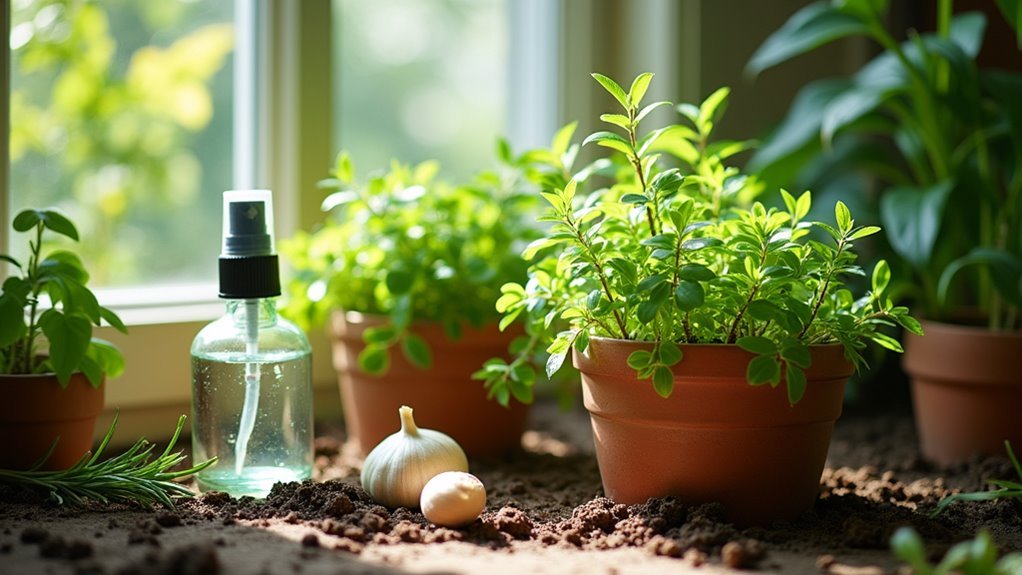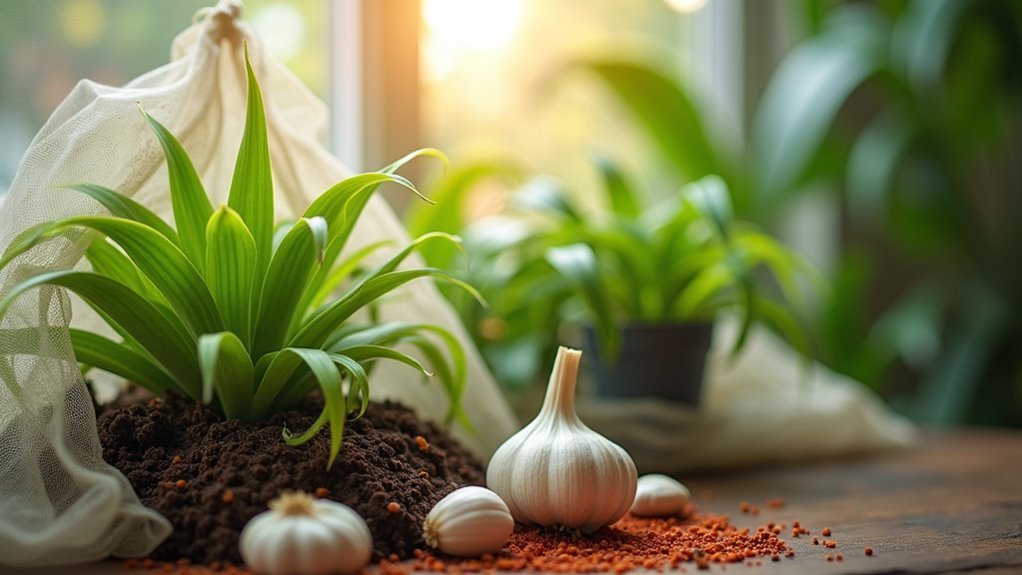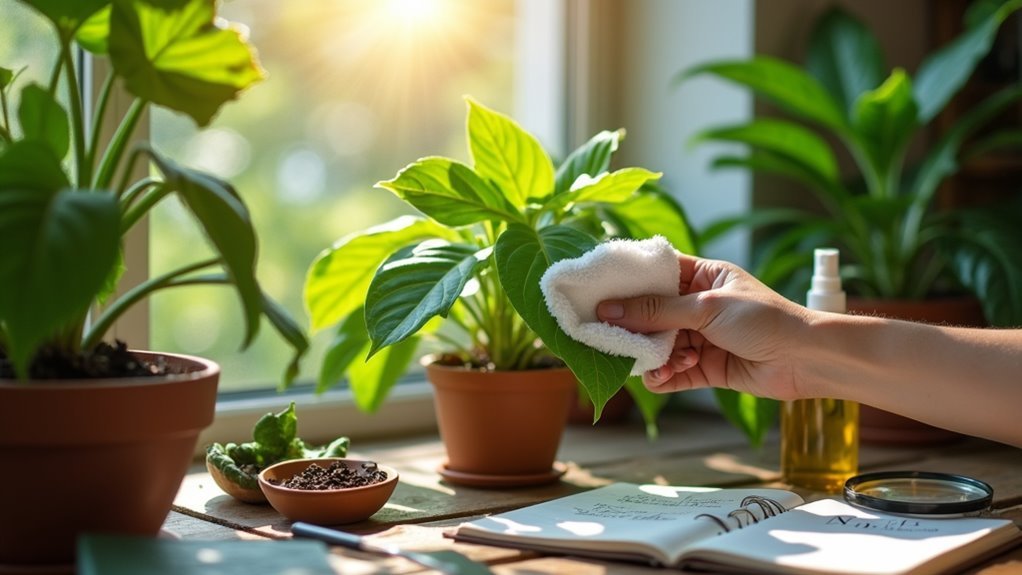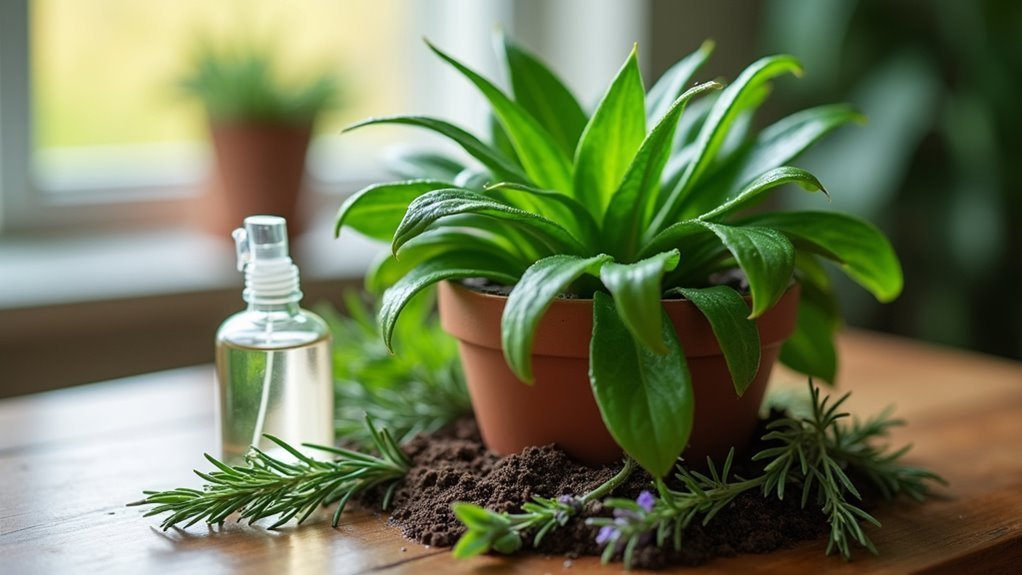You can protect your houseplants from pests naturally by maintaining proper care with adequate sunlight and drainage while avoiding overwatering. Quarantine new plants for 1-2 weeks and inspect them thoroughly before introducing them to your collection. Use physical barriers like sticky traps and diatomaceous earth around plant bases. Apply natural soap sprays made with dish liquid and water every 4-7 days. Clean leaves bi-weekly and monitor plants regularly for early pest detection. These strategies will help you master thorough pest prevention.
Maintain Proper Plant Care and Environmental Conditions

The foundation of pest prevention starts with creating an environment where your houseplants can thrive naturally. Proper care strengthens your plants’ defenses against unwanted invaders.
You’ll want to inspect plants regularly for yellowing leaves or wilting, which signals stress that attracts pests. Master your watering technique by checking soil moisture—only water when it feels dry to prevent fungus gnats from breeding in overly moist conditions.
Stressed plants with yellowing leaves become pest magnets—check soil moisture regularly and water only when dry to maintain healthy defenses.
Provide adequate sunlight based on each plant’s specific needs, as healthy growth naturally deters pest control issues. Guarantee pots have excellent drainage to prevent standing water.
Maintain a clean environment by removing debris and dead plant matter from soil surfaces, eliminating pest nesting sites without harsh natural remedies.
Inspect and Quarantine New Plants Before Introduction
Before bringing any new plant into your home, you’ll need to become a detective and examine every inch for potential hitchhikers. Thoroughly inspect new plants for visible pests like aphids or spider mites that could devastate your existing houseplants. Check leaf undersides and stem junctions for insect clusters or webbing indicating pest activity.
| Inspection Area | What to Look For |
|---|---|
| Leaf surfaces | Aphids, scale insects, discoloration |
| Stem junctions | Insect clusters, sticky residue |
| Soil surface | Fungus gnats, larvae movement |
| Root zone | Soft spots, unusual odors |
After inspection, quarantine new plants for one to two weeks in isolation. This allows you to monitor any developing issues before you introduce them to your main collection, protecting your established plants from potential infestations.
Use Physical Barriers and Preventive Measures

Once you’ve successfully quarantined new plants, implementing physical barriers provides your next line of defense against unwanted pests.
Sticky traps placed strategically near your plants catch flying houseplant pests like gnats and aphids before they establish infestations.
Apply diatomaceous earth around plant bases to create deadly barriers that damage insect exoskeletons.
Soil toppers such as sand or cinnamon disrupt moist environments where pests breed, preventing future pest issues.
These preventive measures work best when you consistently inspect plants for early warning signs.
Elevating pots confuses ant navigation patterns, while removing debris helps you maintain clean plants.
Regular cleaning eliminates hiding spots that harbor destructive insects, making physical barriers more effective against potential threats.
Apply Natural Soap and Oil-Based Deterrents
While physical barriers create your first defense line, natural soap and oil-based sprays deliver targeted attacks against existing pest populations.
You’ll find homemade deterrents incredibly effective for plant care. Mix one teaspoon of dishwashing liquid per liter of water to create a natural soap spray that suffocates aphids and spider mites. Apply this solution to both leaf surfaces every four to seven days.
For stronger protection, combine two tablespoons of dishwashing liquid with half a cup of vegetable oil. Dilute two tablespoons of this oil-based mixture in one liter of water before spraying.
These solutions prevent insects by blocking their air holes and disrupting metabolism. You can enhance effectiveness by adding essential oils like peppermint or thyme, which naturally repel pests while maintaining your plants’ health.
Implement Regular Plant Hygiene and Monitoring

Beyond applying deterrent sprays, maintaining consistent plant hygiene and monitoring routines forms your strongest defense against pest invasions. You’ll catch infestations early by implementing these essential practices that reduce pest attraction and eliminate hiding spots for pests.
| Hygiene Task | Frequency | Purpose |
|---|---|---|
| Regularly inspect leaves | Weekly | Spot discolored foliage, webbing, insect clusters |
| Clean plant leaves | Bi-weekly | Remove dust, improve breathing, deter pests |
| Monitor soil moisture | Every 3-4 days | Prevent overwatering, avoid fungus gnats |
| Remove dead leaves | As needed | Eliminate pest hiding spots |
| Isolate new plants | 1-2 weeks | Observe potential pest issues before mixing |
These simple habits prevent overwatering while keeping your plants healthy and pest-free naturally.
Frequently Asked Questions
How to Keep Indoor Plants Pest Free?
You’ll keep indoor plants pest-free by inspecting them regularly for early warning signs, maintaining proper watering schedules, using natural deterrents like cinnamon, introducing beneficial insects, and ensuring adequate airflow between plants.
What Is the Best Homemade Pest Control for Plants?
You’ll find soap spray works best for most situations. Mix one quart water with four teaspoons dish detergent to dehydrate soft-bodied pests like aphids and spider mites effectively.
How Do I Stop Bugs From Eating the Leaves of My Plants?
You’ll stop bugs from eating leaves by regularly inspecting both sides for pests, then spraying with soapy water solution every few days. Apply cinnamon on soil and use essential oil mixtures for additional protection.
What Repels Bugs From Indoor Plants?
You can repel bugs from indoor plants using essential oils like peppermint or lavender, soap-water sprays, ground cinnamon for fungus gnats, tomato leaf solutions, or diatomaceous earth sprinkled on soil.
In Summary
You’ve got five powerful tools to keep your houseplants pest-free naturally. By maintaining proper care conditions, quarantining newcomers, using physical barriers, applying soap and oil treatments, and staying on top of regular hygiene checks, you’ll create an environment where pests can’t thrive. Don’t wait until you spot trouble – start implementing these preventive strategies today. Your plants will thank you with healthier growth and fewer pest problems down the road.





Leave a Reply